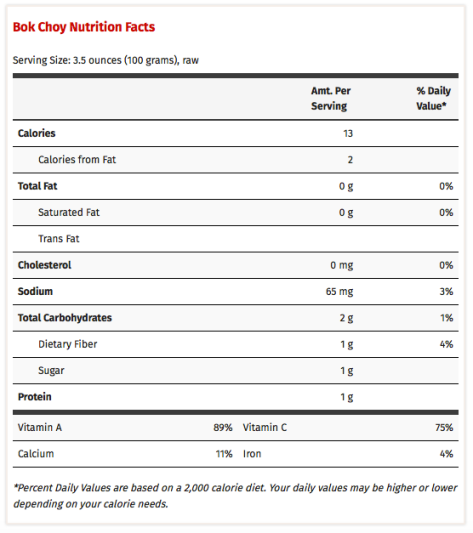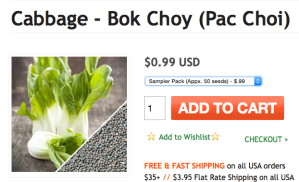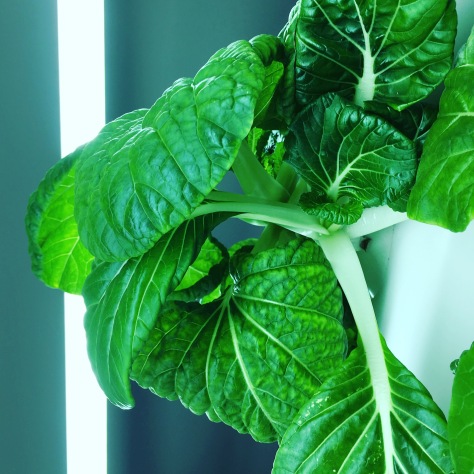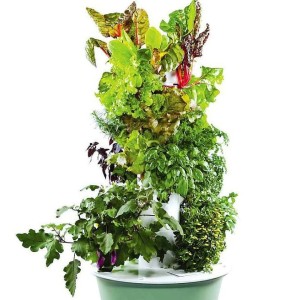Nutritional Benefits of Bok Choy and Why You Should Grow it + Eat It
Bok Choy (Brassica chinensis L.) belongs to a genus in the mustard family called the brassicas. Members of brassica include kale, cabbage, broccoli, cauliflower, and many other similar important food crops.
Bok choy also contains vitamin C, vitamin E, and beta-carotene. These nutrientshave powerful antioxidant properties that help protect cells against damage by free radicals. Nutritionally, bok choy is loaded with cancer-fighting properties as well as a multitude of other health benefits, some of which are still being discovered. Bok choy contains folate. Folate plays a role in the production and repair of DNA, so it may prevent cancer cells from forming due to mutations in the DNA.

Bok Choy Fun Facts
The name “bok choy” originated from the Chinese word for “soup spoon” because of the shape of its leaves.
Bok choy ranks sixth on the Aggregate Nutrient Density Index (ANDI) for fruits and vegetables.

What Vitamin A does for your body…
Vitamin A is important for normal vision, the immune system, and reproduction. Vitamin A also helps the heart, lungs, kidneys, and other organs work properly. In fact, a single cup of bok choy contains the entire RDA of beta carotene, which has been shownto prevent night blindness and possibly reduce the risk of cataract and macular degeneration (source). It is always best to get your vitamin and minerals from a natural food source primarily and important to understand proper levels of Vitamin A intake — please refer to the source listed in the following link to learn more: Department of Health and Human Services.
What Vitamin C does for your body… Vitamin C is required for the biosynthesis of collagen, L-carnitine, and certain neurotransmitters; vitamin C is also involved in protein metabolism [1,2]. Collagen is an essential component of connective tissue, which plays a vital role in wound healing. Vitamin C is also an important physiological antioxidant [3] and has been shown to regenerate other antioxidants within the body, including alpha-tocopherol (vitamin E). It is always best to get your vitamin and minerals from a natural source primarily and important to understand proper levels of Vitamin A intake — please refer to the source listed in the following link to learn more: Department of Health and Human Services.
What Calcium does for your body… Calcium is required for vascular contraction and vasodilation, muscle function, nerve transmission, intracellular signaling and hormonal secretion, though less than 1% of total body calcium is needed to support these critical metabolic functions — the body uses bone tissue as a reservoir for, and source of calcium, to maintain constant concentrations of calcium in blood, muscle, and intercellular fluids. It is always best to get your vitamin and minerals from a natural food source primarily and important to understand proper levels of Vitamin A intake — please refer to the source listed in the following link to learn more: Department of Health and Human Services.
What Iron does for your body… Iron is an essential component of hemoglobin, an erythrocyte protein that transfers oxygen from the lungs to the tissues [1]. As a component of myoglobin, a protein that provides oxygen to muscles, iron supports metabolism [2]. Iron is also necessary for growth, development, normal cellular functioning, and synthesis of some hormones and connective tissue [2,3]. It is always best to get your vitamin and minerals from a natural food source primarily and important to understand proper levels of Vitamin A intake — please refer to the source listed in the following link to learn more: Department of Health and Human Services.
While green vegetables such as bok choy provide your body with many essential vitamins and nutrients, even healthy foods should be eaten in moderation. Too much raw bok choy can have a serious and potentially life-threatening effect on your thyroid gland, and medical professionals advise against overindulging in the raw version of this tasty vegetable. (source)
How to Grow Bok Choy in a Hydroponic System like a Tower Garden:
You can purchase Bok Choy seeds (50 pack) here.

For planting Bok Choy seeds, you’ll want to plant two seeds per 1.5″ rock wool cube, placing the seed about 1/4″ down into the hole of a rock wool cube. Cover with wetted micah. It will typically germinate in 4-7 days. Transplant into your Tower Garden when your starts are approximately 2″ high and as soon as there are true leaves on the plant; this will typically occur in about four weeks from your seed start date.
Ideally, grow Bok Choy indoors with a light source. This will reduce any aphid pressure common from exterior elements. Bok Choy thrives in a temperature range of 55°-75° F with a pH of 6.0-7.5 range and a EC value of 1.5-2.5 (or PPM value of 1120 – 1750).
Be sure to write down your seed starting date as you’ll want to wait to harvest Bok Choy until 8-11 weeks.
Check out the difference between Tower-to-Table Bok Choy vs. Grocery Store Bok Choy Produce offerings.

While checking out the produce section at our local grocery store, I peeked over at the Bok Choy and it was limp and lame — you could tell it had been sitting there for days. One of the key benefits of Bok Choy is its dark green leaves chalk-full of vitamins and minerals. The store Bok Choy begins to lose it’s nutritional benefits the longer it sits on the shelf, that is one of the benefits of having a Tower Garden where you can simply walk over to your indoor garden / garden on your deck and snip off what you need. The Bok Choy on the Tower Garden is similar to Kale — it will continue to regrow if you only take the outer lower leaves so you can get multiple harvests off of the same plant!
When I looked at cost, the store wanted $2.49 per Bok Choy in our neck of the woods (at the time of publishing this article in October of 2018). I plant two Bok Choy plants per rock wool and have four on the same level in my Tower Garden growing — that’s approximately $20 worth of fresh Bok Choy at my finger tips!
When Should I Plant My Hydroponic Tower Garden Bok Choy to Enjoy Fresh For the Holidays?
The advantage of growing in the Tower Garden hydroponic / aeroponic growing system is you can grow all year round with indoor lights! The following are key planting dates if you want to use Bok Choy in holiday sides and dishes (if planting in indoor Tower Garden with lights):
- Thanksgiving Planting-Prep:
Plant your Bok Choy seeds September 30th – October 6th to have in time for Thanksgiving dinner sides/dishes.
 Add Planting Reminder to Google Calendar
Add Planting Reminder to Google Calendar - Christmas Planting-Prep:
Plant your Bok Choy seeds October 4th – October 10th to have in time for optimal Tower-to-Table freshness for Christmas sides/dishes.
 Add Planting Reminder to Google Calendar
Add Planting Reminder to Google Calendar - New Years Planting Prep:
Plant your Bok Choy seeds November 16th – November 23rd to have in time for optimal Tower-to-Table freshness for New Year sides/dishes.
 Add Planting Reminder to Google Calendar
Add Planting Reminder to Google Calendar - Valentine’s Day Planting Prep:
Plant your Bok Choy seeds December 6th – December 20th to have in time for optimal Tower-to-Table freshness for Valentine’s Day dinner sides/dishes. - Easter Dinner Planting Prep:
Plant your Bok Choy seeds February 10th – February 24th to have in time for optimal Tower-to-Table freshness for 2019 Easter Day dinner sides/dishes.
 Add Planting Reminder to Google Calendar
Add Planting Reminder to Google Calendar
How to Use Bok Choy in the Kitchen to Cook and Eat What You Grow
The BEST part of the plant are the green leaves… you can eat the whole plant, but focus on eating whatever is green especially!
-
-
- Try it in an immune-boosting soup like this one (recipe) or this soup recipe featured by “Plated” that incorporates mushrooms which also have health benefits (recipe). Remember, cooking vegetables reduces the number of nutrients they contain. Add your Bok Choy right at the end of the cooking process before you serve your soup. Tip: Try to find a protein-based gluten free noodle if possible.
- Try it in as an element mixed in to stir-fried veggies with chicken like The Mind Full Mom’s idea here (recipe).
- Enjoy it simply sauteed. This Baby Bok Choy recipe by Sam Sifton has a high rating online and worth the try or this recipe on Chow Hound — just a note to be careful with the soy sauce and vegetable broth as these can be high in sodium. The American Heart Association recommends not exceed 1,500 mg of sodium per day.
-



